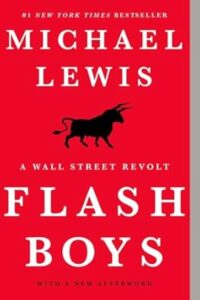
Flash Boys by Michael Lewis
What is it?
In perhaps the single most controversial book on modern finance, Michael Lewis, famous for Liar’s Poker and The Big Short, gives his take on the High-Frequency Trading (HFT) firms that cropped up on Wall Street and eventually became some the largest traders by volume in the American stock market. This book served as an introduction of the secretive HFT industry to many members of the public who may have been shocked to learn that sophisticated algorithms can execute trades so rapidly that even a millisecond advantage can be highly profitable. Readers were also introduced to a variety of technical but fascinating topics like order routing, the National Best Bid and Offer (NBBO) framework, flash crashes, dark pools, and payment for order flow (PFOF), Lewis’s criticism of the HFT was searing; he accused high-speed traders of using their superior speeds to engage in front-running, a form of market manipulation. He also criticized brokers and exchanges of being riddled with conflicts of interests and complex fee structures that make it harder for investors to get the best possible trade execution. The book’s lofty accusations and Hollywood-like narrative helped instantly make it a best-seller and spurred an investigation by the FBI and hearings in the U.S. Senate. However, some journalists and industry experts also panned the book’s portrayal of high-frequency trading as inaccurate, biased, oversimplified, and fictionalized. One person I talked to recommended I check out the book but also cautioned that it was basically a ‘hit piece’ on the HFT industry.
Why does it matter?
Flash Boys’s frenzied response from the public, media, and government demonstrates that readers were quick to level very strong opinions about this industry despite being previously unaware of it. Lewis’s narrative is captivating and managed to take a complex, highly technical topic into the mainstream media. Lewis’s analysis is not fair, in fact in some ways it has had the opposite effect of informing because it has villainized HFT. However the book does reveal the number of stakeholders involved, not limited to: exchanges, brokerage houses, retail investors, institutional investors, HFT firms, and regulatory agencies. Hundreds of stakeholders across the financial world have differing and often competing interests which makes market microstructure and regulation of paramount concern and hugely influential in how much money they might make. With so much money on the line, and so much difficulty for the layman to understand the whole picture, it’s not surprising Flash Boys ended up hitting pop culture like a hand grenade.


